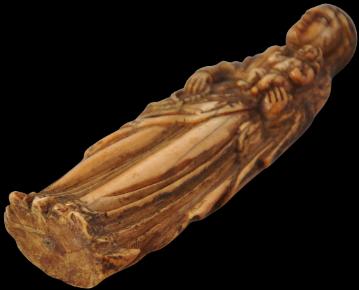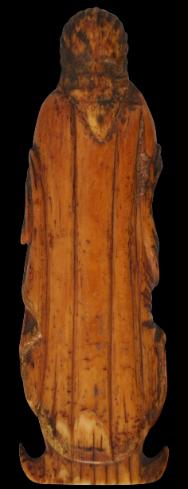
Indo-Portuguese Christian Ivory – Goa
Ivory Figure of the Virgin & Child
Portuguese Goa, India
16th-17th century
height: 10.5cm
This image of Mary, the Mother of Jesus, shows her with the infant Jesus in on arm and hold a string of rosary beads in the other. The image has an extraordinarily deep patina. The back of the image particularly has a hue almost akin to that of reddish wood. This is clearly an early ivory. Another hint as to its age are the features of Mary herself: her face clearly has Indian features. Her hairstyle, thick and long, also is more Indian than European, and her robes have a sari element. The robes are long a flowing, and Mary stands on a crescent moon or medialuna.A particularly early dating for this ivory is a possibility – an ivory image of the Virgin and Child with very similar characteristics is in the Palazzo Pitti, Florence and which first appears in inventory records in 1601 (Trnek & Haag, 2001, p. 142.)
Christian ivories from India such as this example made their way as direct imports to Europe, particularly Spain and Portugal, where they entered the
treasuries of churches and monasteries. Others were sent to Spain and Portugal’s dominions such as Mexico and the Philippines from where they might also
have been exported to Europe. Others still entered aristocratic collections and European cabinets of curiosities as curios and collector’s pieces. Juana de
Cordoba y Aragon, the Duchess of Frias, is known to have owned around fifty such pieces in 1604 (Trusted, 2007).
Goa had a fractious history before coming under Portuguese control. It came under the governance of the Delhi Sultanate in 1312. But the Sultanate’s hold
over the region was weak. By 1370, the region was surrendered to the Vijayanagara empire. The Vijayanagara monarchs held the territory until 1469, when it
fell to the Bahmani sultans of Gulbarga. With the fall of that dynasty, the area fell to the Adil Shahis of Bijapur who established as their auxiliary capital the
city known under the Portuguese as Velha Goa. In 1510, the Portuguese defeated the ruling Bijapur kings with the help of a local ally, Timayya. They founded
a permanent settlement in Velha Goa (Old Goa). With the Portuguese, came Christianity. From the sixteenth century, Goa which formerly had been a remote
province on the periphery of kingdoms, became an eastern trading capital of the Portuguese empire and the seat of Christian imperialism and influence whose
influence stretched from the Cape of Good Hope to the Sea of Japan.
The Portuguese expanded their possessions around the region so that by mid-18th century the area under occupation included most of Goa’s present day
state limits. In 1843 the capital was moved to Panjim from Velha Goa.
After India gained independence in 1947, Portugal refused to negotiate with India on the transfer of sovereignty of its Indian enclaves. In December 1961, the
Indian army annexed Goa and several smaller Portuguese possessions, ending Portugal’s 400 year presence in the Indian sub-continent.
Many Goans converted to Christianity under the Portuguese. Local religious art developed syncreatic elements: it was predominantly Christian but
incorporated Hindu Indian influences. The Jesuits played a critical role in Goa: Francis Xavier, the Spanish-born pioneering Roman Catholic and co-founder of
the Society of Jesus (the Jesuits) was ordered by Ignatius Loyola, the principal founder of the Jesuits, on behalf of the Portuguese king to undertake a mission
to the Portuguese East Indies. The king had become concerned that Christian values in the possessions had become deteriorated. Xavier left Lisbon in April
1541, and after first visiting Mozambique he reached Goa in May 1542, where he spent the next three years strengthening the position of the Church.
Thereafter, the Jesuits played a key role in developing the Church’s infrastructure in Goa: churches, monasteries and Catholic schools were built.
The condition of the ivory here is very good – there are no obvious chips, repairs, cracks or losses – just a superb patina. The image stands freely and in a stable manner.
References
Carreau, R., Devotion Baroque: Tresors du Musee de Chaumont, Somogy Editions D’Art, 2009.
Curvelo, A.,
et al, The Orient Museum, Lisbon, Reunion des Musees Nationaux, 2008.
Levenson, J.A,
et al, Encompassing the Globe: Portugal and the World in the 16th & 17th Centuries, Arthur M Sackler Gallery, 2007.
Manuel Fores, J.,
et al, Os Construtores do Oriente Portugues, Comissao Nacional Para as Comemoracoes dos Descobrimentos Portugueses, Porto,1998.
Museum of Christian Art,
Museum of Christian Art, Rachol, Goa, 1993.
Trnek, H., & S. Haag (eds.),
Exotica: Portugals Entdeckungen im Spiegel furstlicher Kunst – und Wunderkammern der Renaissance, Kunsthistorischen Museums Wien, 2001.
Inventory no.: 1552
SOLD





